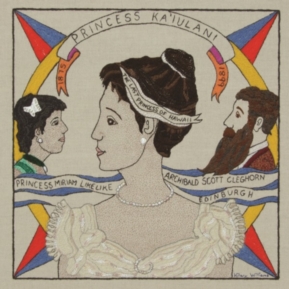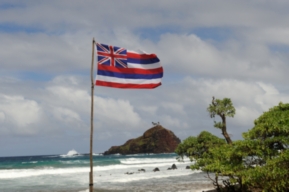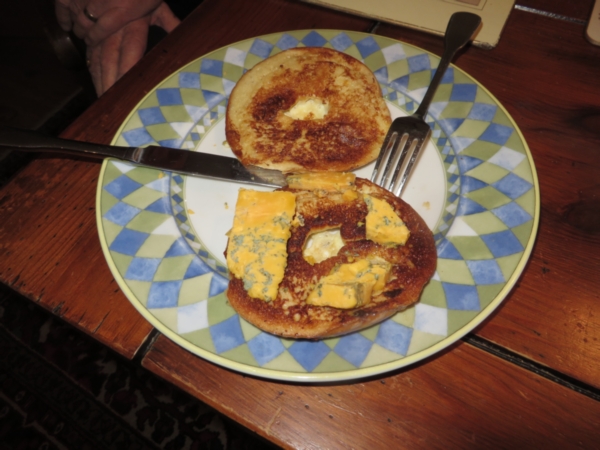Leviticus 191/84: Hawaiian & Panamanian Independence ... and French Toast?
Independence for Hawaii from the British by the British! In 1843, in an altogether strange episode, Captain Lord George Paulet of the Royal Navy demanded "the provisional cession" of Hawaii to Great Britain in pursuit of a land dispute and the British flag flew over the Islands for five months until …. British Admiral Richard Thomas arrived to rescind that cession and negotiated a favourable trade treaty! Admiral Thomas declared Kauikeaouli (King Kamehameha III) its independent sovereign. November 28th is celebrated as the date of the Joint Anglo-French Declaration recognising its independence. The Kingdom lasted until 1893 when it was 'overthrown' by a US backed coup by American sugar plantation settlers setting up a Republic which was annexed by the USA. It became a US state in 1959. The Last Princess of Hawaii was of Scottish descent and is remembered in the Diaspora Tapestry US15A. The state flag below was adopted by the Kingdom to commemorate a gifted flag from King George. The horizontal stripes represent the eight islands of the Kingdom.
 
In 1821 on even date Panama celebrated independence from Spain and joined Gran Colombia. Though home to indigenous tribes Panama came under Spanish control with the arrival of settlers in the 16th century. From 1538 until 1821 Panama was governed as part of the Viceroyalty of Peru. The strategic position of Panama then and still to this day made the area one of the wealthiest and most prestigious in the region. This helped to forge a sense of pride in a national identity quite early on amongst the new generations of settlers. With the independence movements that were sweeping across this part of the Americas the hand of the Panamanian independence movement was forced when the small town of Villa de Los Santos made the first cry on November 10th 1821. On 28th November at an open meeting Panama was declared a sovereign entity but fearing reprisals sought protection from and became a department within the federal Republic of Gran Colombia just established by Simón Bolívar the same year that stretched from Venezuela to Northern Peru. It was short lived and from 1831 till 1903 Panama remained part of the 'new' Colombia only. On November 6th 1903 the US recognised the Republic of Panama and on November 18 the Hay-Bunau-Varilla Treaty was signed granting the US exclusive and permanent possession of the Panama Canal Zone and in exchange Panama received US$10 million and an annuity of US$250,000 beginning nine years later. In 1979 the US formally withdrew from the Canal Zone. Our visit there was memorable for coinciding with Mardi Gras in Panama City when we visited the HQ of Learning Services International [LSI] SA for which I have worked as an international consultant for nearly 40 years now.
… Yes, it's French Toast Day. That was a tad difficult although we had plenty of eggs having double ordered earlier in the week. We went out of stock with smoked cod and poached egg so I bought new on an ad hoc shopping trip whilst Avril had it all listed for Tesco's Click & Collect = 21 eggs! French toast goes by many names depending on where it’s being served – eggy bread, German toast, Poor Knights’ Pudding or Bombay toast – but it’s always got the same key ingredients. Egg, milk or cream and bread. It's often served with sugar or syrup and fruit. In France, its name is pain perdu because it will often be made with stale or old bread. This morning I omitted any eggs or milk and just toasted the cranberry and sunflower loaf and ate it dry with Avril's compôte [that's French surely?] of Manor House apples and Morrison's blackberries. Those berries the same trip as the extra eggs. Prescient obviously. Although we tend to call it French toast it's not known to have come from France. Some ancient Latin recipes from the 4th century mention soaking bread in milk before frying and 14th century Germany used that Poor Knights’ Pudding. In Italy there’s a savoury version called mozzarella en carrozza which sees the egg-soaked bread sandwiching slices of mozzarella cheese before frying. Its name literally means mozzarella in a carriage. I'm going to attempt it with bagel and blue cheese for lunch today and see if Avril can be tempted too. We had success in my case formaggio blu della Shropshire en carrozza as pictured as yet unfolded; and Avril's was certainly not Bombay Toast - she had gluten free roll with plenty of cheddar chunks - rotolo senza glutine con pezzetti di cheddar.

P.S. The Manor House just lit up the silver birch tree with three grazing reindeer and an illuminated front door wreath; pictures tomorrow then!
Published Date: November 28th 2020
|





